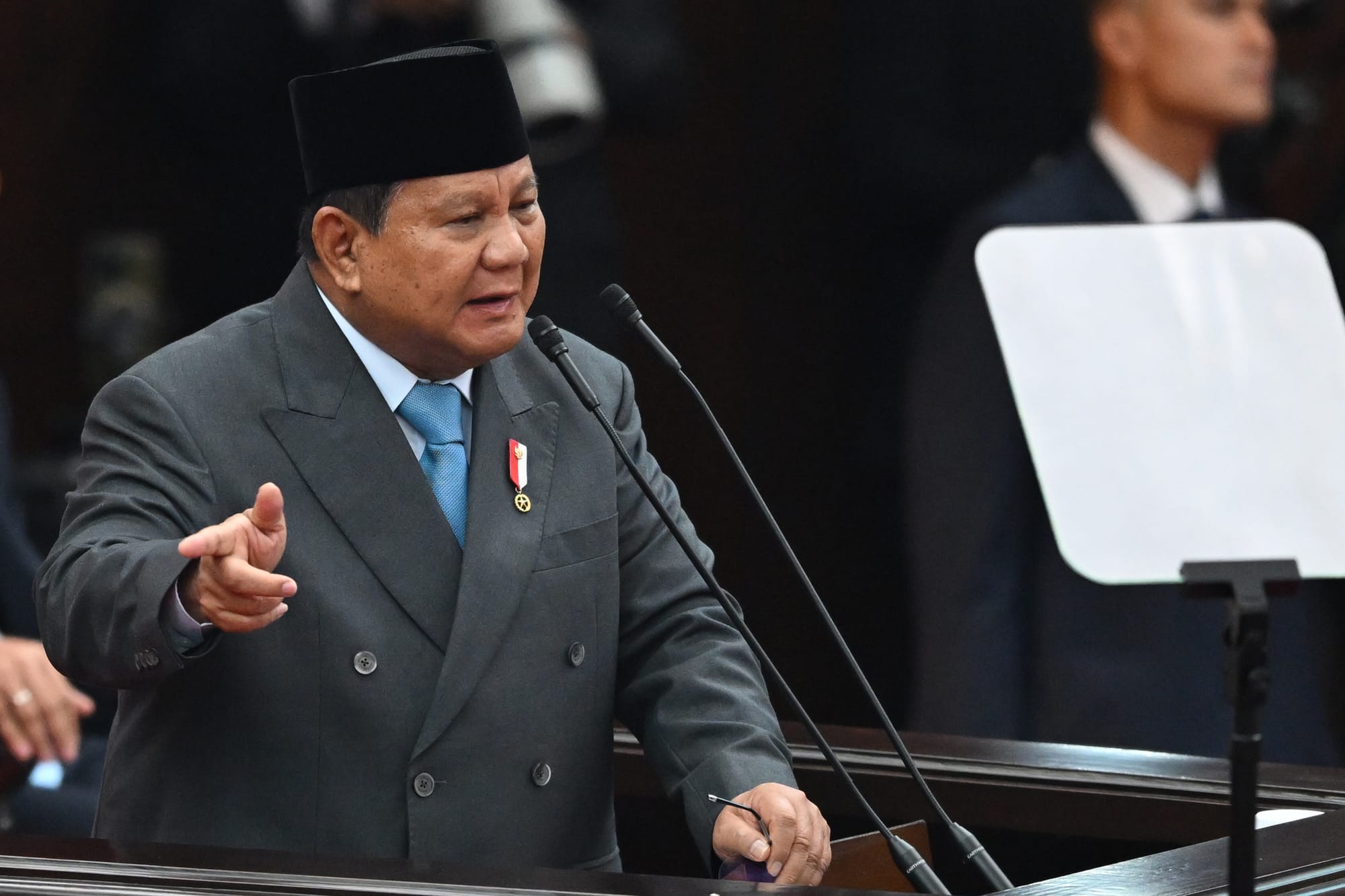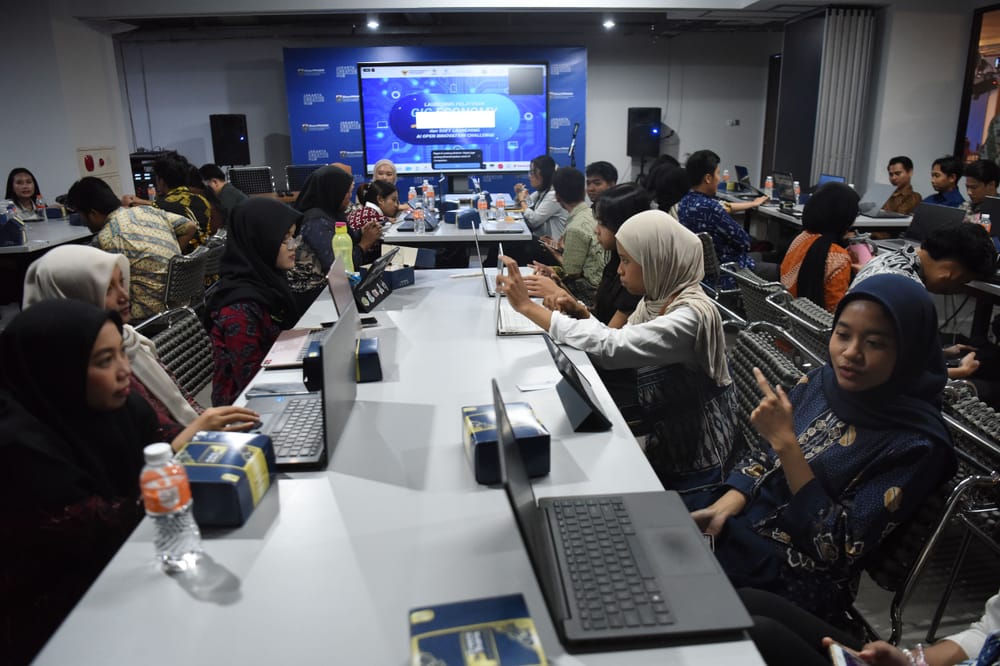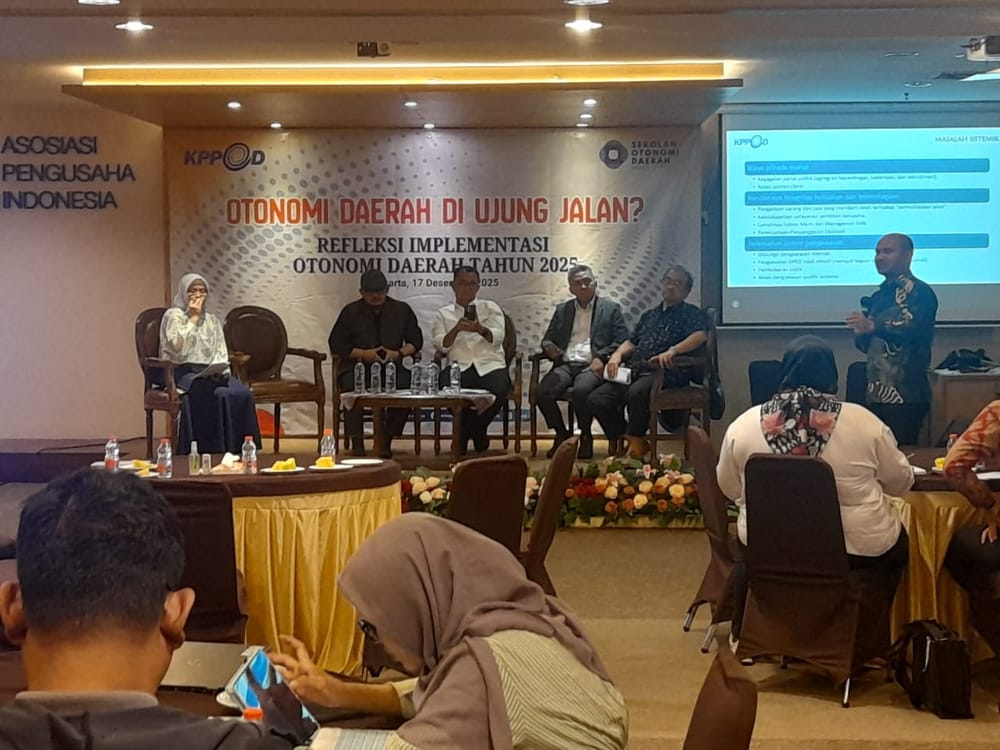The Financial Note and the Draft State Budget (RAPBN) for 2026, presented by President Prabowo Subianto in his state address at the Parliament Complex, Jakarta, Friday (15/8/2025), illustrates a grand ambition to realize his vision and mission in 2026. Amid limited fiscal space, the president wants to immediately step on the gas to fulfill his promises with eight priority agendas and 5.4% economic growth.
“This is the first State Budget that I have formulated as President of the Republic of Indonesia. The architecture of the 2026 State Budget is an implementation of the vision and mission of myself and the Vice President, which is directed towards realizing a strong, independent, and prosperous Indonesia,” said Prabowo opening his speech.

One of the highlights of Prabowo's speech was a flagship program touted as a “new legacy” of his government. Among them, the free nutritious meal program (MBG) which has reached 20 million beneficiaries in 2025 and is targeted to expand to 82.9 million students, pregnant women, and toddlers in 2026. With an allocation of Rp335 trillion, MBG will be the largest public nutrition program in Indonesian history.
In addition, there is a free health check program that 17 million citizens have enjoyed this year, as well as the revitalization of more than 13,000 schools and madrasas. To support the village economy, the government is forming 80,000 Koperasi Merah Putih (Red and White Cooperatives) with complete facilities: warehouses, cold storage, outlets, to a fleet of distribution trucks.
“We must no longer allow people to borrow money from loan sharks. We will eliminate bloodsuckers from the earth of Indonesia,” said Prabowo in a speech that was greeted with applause from members of the legislature.
Beyond flagship programs, the 2026 Draft State Budget is designed with eight main focuses: food security, energy security, superior generation through MBG, quality education, equitable health, a cooperative-based people's economy, total people's defense, and acceleration of global investment.
For food security, the government is preparing Rp 164.4 trillion, including fertilizer subsidies of Rp 46.9 trillion and strengthening Bulog as a stock buffer. The target is self-sufficiency in rice and corn. “Stable prices, prosperous farmers, prosperous fishermen,” said Prabowo.
Energy received an even greater allocation of Rp 402.4 trillion. The target set is the use of 100% electricity generation from new and renewable energy within 10 years. “Indonesia must become a pioneer in the world's clean energy,” he emphasized.
Education and health also receive significant attention. The education budget is set at 20% of the state budget, amounting to Rp 757.8 trillion, the largest in history. Meanwhile, the health sector receives Rp 244 trillion, including coverage for health insurance for 96.8 million poor and vulnerable people.
Defense is not left behind either. With historical rhetoric, Prabowo reminded how the archipelago was once "trampled by other nations" due to weak defense. Now, he asserts that Indonesia must no longer be a "milking cow." The modernization of the main weaponry system (alutsista) and the strengthening of strategic reserves are also on the priority agenda.
These eight major focuses are summarized by Finance Minister Sri Mulyani as a continuation of the President's Asta Cita. "The 2026 state budget remains healthy and is maintained as an instrument to strengthen the foundation of a resilient, independent, and prosperous Indonesia," said Mulyani.

Mulyani emphasized the state budget as an instrument of justice. "Central and regional spending must be aligned. Even though the central government is spending, the people in the regions benefit through the PKH, KIP, basic food cards, health services, public schools, free nutritious meals, and the Red and White cooperatives," she said.
But fiscal is limited
The magnitude of the agenda has caused the 2026 state budget to swell. State spending is designed at Rp 3,786.5 trillion, while revenue is only Rp 3,147.7 trillion. The deficit reaches Rp 386.8 trillion, or 2.48% of GDP.
Mulyani explained that state revenue projections are targeted to grow 9.8% compared to the previous year. This target is driven by increased tax revenue and optimization of revenue from customs and excise, although Non-Tax State Revenue (PNBP) has slightly decreased.
Revenue from taxes is targeted to reach Rp 2,357.7 trillion, which means it must grow by 13.5%. Meanwhile, revenue from customs and excise is estimated to reach Rp 334.3 trillion, or an increase of 7.7%.
On the other hand, PNBP (Non-Tax State Revenue) decreased by 4.7% to Rp 455 trillion, mainly due to the absence of SOE dividends.
Prabowo emphasized that this deficit is still within safe limits. In fact, he aspires to be able to close the deficit completely before 2028. This means Prabowo is targeting a balanced budget. "I want to one day stand on this podium and announce that we have succeeded in having a state budget that has no deficit at all," he said.
The 2026 state budget deficit is set at 2.45% of GDP, lower than the 2025 deficit target of 2.7%. Mulyani calls this a signal of fiscal discipline. On the other hand, experts warn that fiscal health cannot be measured by the deficit alone.
Deni Friawan, a researcher at the Department of Economics CSIS, also highlighted the direction of state spending, which is considered full of political agendas. "The 2026 Draft State Budget is full of populist programs, such as free meals, 3 million homes, and the Red and White Cooperative. The question is, with limited fiscal space, what will be sacrificed?" said Deni (18/8/2025).
He added that such policies have the potential to create a crowding out effect, where private consumption and investment are suppressed by the dominance of government spending. "Instead of strengthening economic stability, this policy could threaten it," he said.
Budget centralization is also a concern. "There is a tendency for budget centralization in the central government, while the role of local governments is shrinking due to cuts in transfers to the regions," said Deni.
The 2026 Draft State Budget data shows that central government spending is projected to increase by 17.8%, while transfers to the regions are actually down 24.8%. According to CSIS, this trend will widen the inequality of fiscal capacity between regions and risks hindering equitable development.
The state revenue target is also considered ambitious. The government is targeting a 10% increase, mainly from taxes of 13%. In fact, according to a CSIS study, the average tax increase so far has only been around 5%-6%.
"Only 17 million out of 155 million workers pay taxes. Our tax base is still very narrow, making it difficult to force an increase in revenue in a short time," said Deni. If the target is not achieved, the shortfall could be covered through new debt, which would only increase fiscal pressure.
The allocation of state spending also raises questions. "Capital expenditure continues to decline. In fact, this determines long-term production capacity," said Deni.
Conversely, defense and security spending jumped to 18% of the total 2026 Draft State Budget, exceeding the allocation for social protection. "Defense and security spending controls 18% of the 2026 Draft State Budget, which is greater than social protection. The question is, are we at war?" said Deni.
Deni also highlighted the issue of subsidies. Energy subsidies rose 14% and absorbed 66% of total subsidies.
"In fact, energy subsidies are mostly enjoyed by affluent groups," said Deni. CSIS believes the government should change its approach, from subsidizing goods to directly subsidizing recipients. "Subsidies should be given directly to people, not to goods, so that they are more targeted," he said.
Meanwhile, economist Riza A Pujarama from the Institute for Development of Economics & Finance (Indef) highlighted the increasingly sharp trend of budget centralization in the 2026 Draft State Budget. Central government spending is projected to increase by 17.8%, while Transfers to Regions and Village Funds (TKDD) are down 24.8%.
"In 2026, TKDD will decrease by up to Rp214 trillion compared to the 2025 state budget outlook, its composition shrinking from 24.49% to 17.17%, while central government spending will be 82.83%. This is a consequence of the Job Creation Law, which reduces regional authority," said Riza, an Indef economist.
The reduction in revenue sharing, special autonomy, and village funds is putting pressure on the fiscal capacity of more than 500 regencies/cities, which risks hindering equitable development. The impact on regional independence is also a serious concern.
Riza emphasized, "It may be that independent regions no longer depend on transfer funds, but it is necessary to delve deeper to understand the impact of reducing TKDD on more than 500 regencies/cities in Indonesia."
The dominance of central government spending on routine expenditures, especially employee expenses, goods expenses, and debt interest payments, also reinforces this dynamic. Productive capital expenditure is actually shrinking, from 8.74% in the 2026 Draft State Budget (RAPBN), so that infrastructure investment that can drive long-term growth is limited.
2026 economic growth target
Not only budgeting for jumbo spending, the government also conveyed a number of high basic macro assumptions for 2026. The 2026 economic growth target is targeted to reach 5.4%, higher than the 2025 State Budget of 5.2%, even though this year's outlook is for the economy to grow in the range of 4.7%–5.0%.
Yose Rizal Damuri, Executive Director of the Centre for Strategic and International Studies (CSIS), assesses that the 5.4% growth target exceeds the projections of international institutions. The World Bank and the IMF predict that the Indonesian economy in 2026 will only grow by around 5%. “There is a gap between ambition and reality,” said Yose, in a media briefing “2026 Draft State Budget: Considering Political Promises Amidst Fiscal Limitations" held at the CSIS Auditorium on Monday morning (18/8/2025).
According to him, optimism is indeed needed to move the bureaucracy and the market, but the government must prepare a backup scenario if growth misses the mark. For example, the impact of China's slowdown, US monetary tightening, to a new trade war.
“One of the main assumptions of the 2026 Draft State Budget is economic growth of 5.4 percent. In fact, if we look at the medium-term projections submitted by Bappenas since 2019, the figure is much lower than that,” said Yose Rizal, Executive Director of CSIS.
Yose assesses that growth of that size is difficult to achieve when Indonesia's main export engines, namely commodities such as CPO, coal, nickel and gas, are weakening in terms of both price and demand. These commodities contribute around 40% of national exports.
“If commodity prices fall, our economic growth also tends to fall. So, the assumption of 5.4 percent growth will be difficult to achieve,” he said.
Responding to the 2026 economic growth target of 5.4%, the Chairperson of the Indonesian Employers' Association (Apindo), Shinta W Kamdani, said that her party would welcome it with optimism accompanied by caution.
She emphasized that achieving this target is highly dependent on several key factors, both from a macroeconomic perspective and improvements to the business climate.
"We view the 2026 economic growth target of 5.4% as something that needs to be viewed with optimism but with caution, especially with the continued existence of global uncertainty," Shinta told SUAR (16/8/2025).
According to her, economic growth next year will depend on the speed of investment realization, the effectiveness of government priority spending, the resilience of people's purchasing power, and the strengthening of the export sector.
She provided several notes that are challenges for business actors such as the cost of doing business in Indonesia is still high, especially in the energy, logistics, financing and loan interest sectors. In addition, the cost of compliance with regulations and permits is also still a concern for Apindo.
Furthermore, she emphasized that Indonesia needs to create a more conducive and competitive investment climate in order to attract foreign capital.
"We also highlight the need to increase productivity, which is one of the factors in accelerating investment realization," she added.
"We also highlight the need to increase productivity, which is one of the factors in accelerating investment realization," said Shinta.
Shinta Kamdani refers to the State Budget as the "DNA of national growth" which determines the direction of the economy, development priorities and distribution of resources. However, she emphasized that a solid State Budget will not be effective without strategic collaboration between the government and the private sector.
In the context of state revenue, Apindo supports tax reform through a data and risk-based Coretax system. However, Shinta emphasized the importance of legal certainty, transparency and consistency. She also encouraged the government to explore new revenue potential, such as from the shadow economy or informal economy, which is estimated to cover around 23.8% of GDP.
“Amidst the various challenges that exist, to achieve this growth target, Apindo welcomes the synergy between the government and the business world through Indonesia Incorporated, where the business world always continues to provide input based on field data that is of concern to the government,” said Shinta.
On the other hand, Macroeconomics and Financial Market Researcher at the Institute for Economic and Community Research, University of Indonesia (LPEM UI), Teuku Riefky, is of the opinion that other assumptions that underlie the preparation of the 2026 Draft State Budget, such as inflation or exchange rates, are within a reasonable range.
However, he has a different projection for economic growth and estimates that the figure will not reach 5.4% in 2026.
“I think the others [macroeconomic assumptions] are quite realistic, except for economic growth. In my opinion, next year economic growth will not reach 5.4 percent,” he explained to SUAR (15/8/2025).
He emphasized that strengthening the state budget posture should not be done by increasing tax rates. He proposed a more innovative and structural strategy to increase state revenue, namely through the use of the Population Identification Number (NIK) and job creation.
Riefky sees great potential in using NIK as a tool to track people's income more accurately. With this system, the government can identify potential taxes that have not yet been recorded, especially from the informal sector. "Using NIK to track people's income and reduce the cost of informality also significantly affects state revenue," he said.
Furthermore, Riefky emphasized that increasing state revenue cannot stand alone. He argues that fiscal policy must be supported by broader structural policies, especially to create jobs.
"There needs to be a structural policy that encourages job creation so that it can increase people's purchasing power," he said.
"There needs to be a structural policy that encourages job creation so that it can increase people's purchasing power," said Riefky.
According to him, job creation will automatically increase people's income and purchasing power, resulting in economic activity, which in turn will increase the tax base and overall state revenue.






